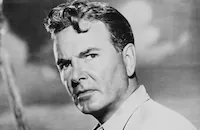Africa Adventure

Brief Synopsis
Cast & Crew
Robert C. Ruark
Robert C. Ruark
Harry Selby
Andrew Holmberg
John Sutton
Jay Bonafeld
Film Details
Technical Specs

Synopsis
This documentary chronicles the exploits of a safari, headed by American Robert C. Ruark, as it journeys through the rugged terrain of East Africa. After describing the trip from the United States to Nairobi, Kenya, Ruark introduces other members of the safari, including professional hunters Harry Selby and Andrew Holmberg. In their truck, packed tightly with food, medicine and equipment, the men travel first to the northern frontier village of Isiola, where they are greeted by elephant-eating Turkana tribesmen and brightly dressed Somalis. As the safari continues deeper into the frontier, Ruark notes that special precautions were taken to avoid Mau Mau rebel attacks. At a river bed on the arid Kenyan plains, the safari encounters rhinoceros, gazelles, guinea fowl and elephants, all competing for the same precious water. After members of the nomadic Rendille-Samburu tribe show Ruark how a huge bull elephant destroyed one of their water wells, Ruark and his fellow hunters pledge to kill the animal. Accompanied by Kenyan police, the men search the area until the elephant, an outcast, is spotted. Despite a sudden rainstorm, the hunters shoot the animal dead and are thanked by the Rendille-Samburu, who look forward to selling the bull's valuable 110-pound tusks. The hunters then take on a large rhinoceros, felling him with their rifles. Next, the safari meets a band of Samburu tribesmen, who entertain the men with their ritualistic jumping dance. After three weeks of hunting and photo taking, the safari ventures into Uganda, where their truck is impounded by the local authorities. Eventually another truck is secured, and Ruark's wife and hunter John Sutton join the group. Near Lake Edward, the safari encounters hippopotami and a large elephant herd. The group then heads for the Masai region of Kenya, where Masai warriors show off their lion mane headdresses. The process of setting up camp, hunting for dinner, and cooking in the wild is detailed. Later, the hunters set out to find a herd of big-horned buffalo, spotting baboons and antelope along the way. After a determined pursuit, the men zero in on a huge male buffalo in the brush and quickly shoot it. Ruark admires its forty-nine inch head, noting that it will make an excellent wall trophy. The safari next observes a pride of lions as well as hyenas and vultures. As spring begins, Ruark undertakes his final hunting challenge, the killing of a leopard. Using a dead wart hog as bait, Ruark lures the usually nocturnal leopard into a tree and shoots it from a distance. The wounded cat falls from the tree and runs into the brush, but dies soon after. Commenting that he "just doesn't like leopards," Ruark inspects his kill with pride, then declares that his wife will appreciate its fur. After three months of adventure, the safari concludes, and the Ruarks return to the United States.

Director
Robert C. Ruark
Cast
Robert C. Ruark
Harry Selby
Andrew Holmberg

John Sutton
Crew

Film Details
Technical Specs

Quotes
Trivia
Notes
The film's title card reads: "Robert C. Ruark's Africa Adventure." Ruark's second onscreen credit reads: "Written and narrated by Robert C. Ruark." Onscreen credits note that the picture was made "in cooperation with Voyager Productions, Inc." and include the following statement: "Appreciation is acknowledged to the Kenya Game Department." Although the film was originally presented in color, the viewed print was in black and white. The following foreword, written by Ruark, a syndicated Scripps-Howard columnist, opens the film: "This is a motion picture in which I have attempted to show Africa as it actually is, and some of the aspects of its life and death. Nothing in this picture was staged or contrived. If at times it rains, or the camera shakes, it is because it actually was raining or the cameraman was frightened. It is easy to be frightened if you are dealing with large, angry animals. So much nonsense about African safaris has been filmed that I think it's time one was made with most of the fraud removed. There is no fraud in this picture and no heroes, either. It is a movie of what you might see if you were ever lucky enough to get to Africa."
In March 1953, Mau Mau rebels, whose anti-British activities are alluded to several times in the picture, were involved in a massacre in Lari, Kenya, and in April 1954, the government neutralized their Central Committee, effectively curtailing their power. Producer Jay Bonafeld also made Savage Splendor, another African safari documentary released by RKO in 1949 (see AFI Catalog of Feature Films, 1941-50).













